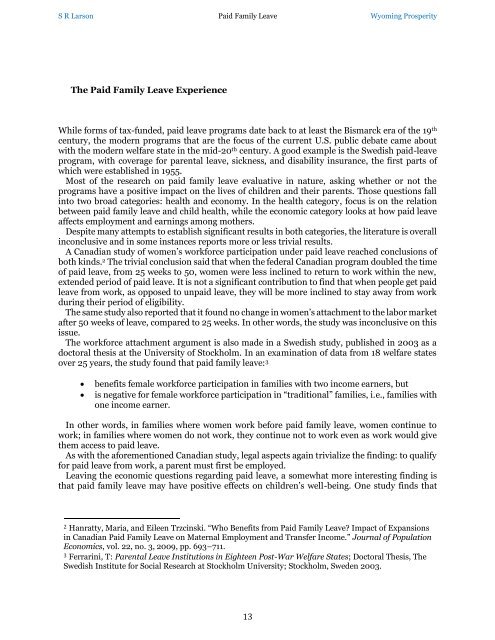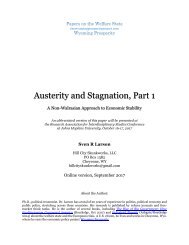Welfare State Paper 1 Paid Family Leave copy
You also want an ePaper? Increase the reach of your titles
YUMPU automatically turns print PDFs into web optimized ePapers that Google loves.
S R Larson <strong>Paid</strong> <strong>Family</strong> <strong>Leave</strong> Wyoming Prosperity<br />
The <strong>Paid</strong> <strong>Family</strong> <strong>Leave</strong> Experience<br />
While forms of tax-funded, paid leave programs date back to at least the Bismarck era of the 19 th<br />
century, the modern programs that are the focus of the current U.S. public debate came about<br />
with the modern welfare state in the mid-20 th century. A good example is the Swedish paid-leave<br />
program, with coverage for parental leave, sickness, and disability insurance, the first parts of<br />
which were established in 1955.<br />
Most of the research on paid family leave evaluative in nature, asking whether or not the<br />
programs have a positive impact on the lives of children and their parents. Those questions fall<br />
into two broad categories: health and economy. In the health category, focus is on the relation<br />
between paid family leave and child health, while the economic category looks at how paid leave<br />
affects employment and earnings among mothers.<br />
Despite many attempts to establish significant results in both categories, the literature is overall<br />
inconclusive and in some instances reports more or less trivial results.<br />
A Canadian study of women’s workforce participation under paid leave reached conclusions of<br />
both kinds. 2 The trivial conclusion said that when the federal Canadian program doubled the time<br />
of paid leave, from 25 weeks to 50, women were less inclined to return to work within the new,<br />
extended period of paid leave. It is not a significant contribution to find that when people get paid<br />
leave from work, as opposed to unpaid leave, they will be more inclined to stay away from work<br />
during their period of eligibility.<br />
The same study also reported that it found no change in women’s attachment to the labor market<br />
after 50 weeks of leave, compared to 25 weeks. In other words, the study was inconclusive on this<br />
issue.<br />
The workforce attachment argument is also made in a Swedish study, published in 2003 as a<br />
doctoral thesis at the University of Stockholm. In an examination of data from 18 welfare states<br />
over 25 years, the study found that paid family leave: 3<br />
• benefits female workforce participation in families with two income earners, but<br />
• is negative for female workforce participation in “traditional” families, i.e., families with<br />
one income earner.<br />
In other words, in families where women work before paid family leave, women continue to<br />
work; in families where women do not work, they continue not to work even as work would give<br />
them access to paid leave.<br />
As with the aforementioned Canadian study, legal aspects again trivialize the finding: to qualify<br />
for paid leave from work, a parent must first be employed.<br />
Leaving the economic questions regarding paid leave, a somewhat more interesting finding is<br />
that paid family leave may have positive effects on children’s well-being. One study finds that<br />
2 Hanratty, Maria, and Eileen Trzcinski. “Who Benefits from <strong>Paid</strong> <strong>Family</strong> <strong>Leave</strong>? Impact of Expansions<br />
in Canadian <strong>Paid</strong> <strong>Family</strong> <strong>Leave</strong> on Maternal Employment and Transfer Income.” Journal of Population<br />
Economics, vol. 22, no. 3, 2009, pp. 693–711.<br />
3 Ferrarini, T: Parental <strong>Leave</strong> Institutions in Eighteen Post-War <strong>Welfare</strong> <strong>State</strong>s; Doctoral Thesis, The<br />
Swedish Institute for Social Research at Stockholm University; Stockholm, Sweden 2003.<br />
13



